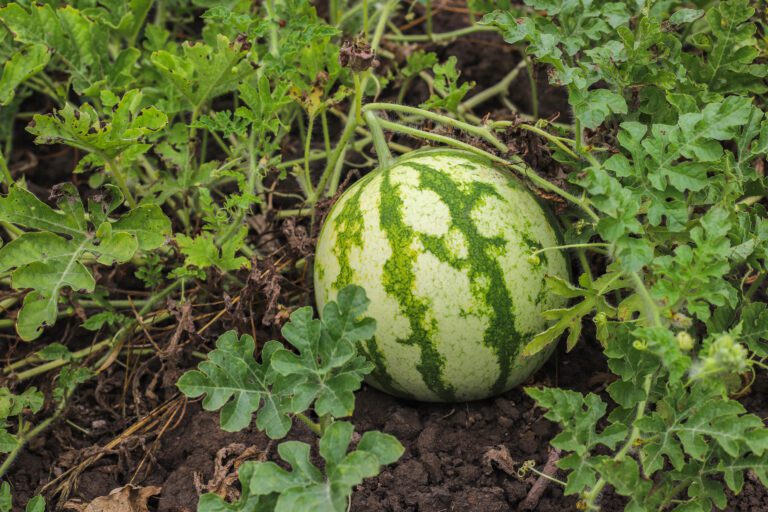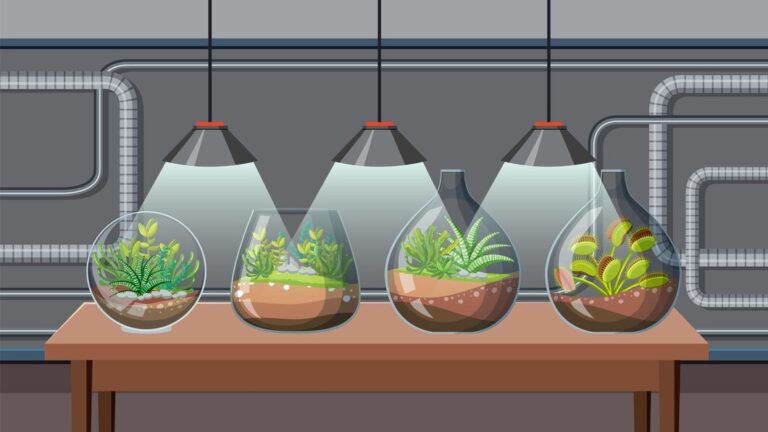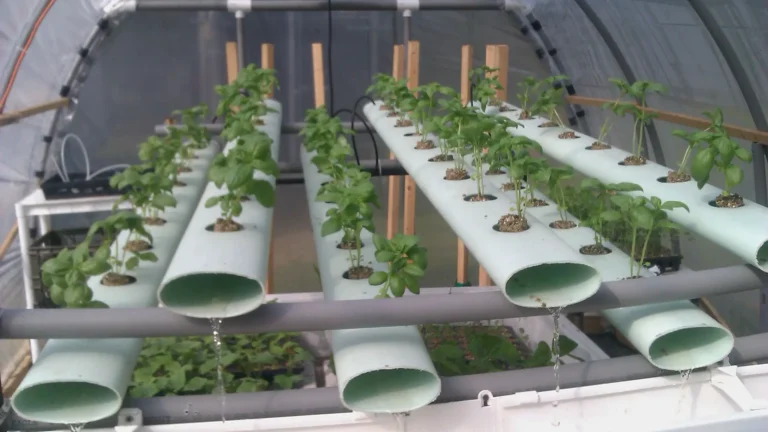Grow Your Own Hydroponic Strawberries in a Soil less System
Table of Contents
Introduction
Hydroponic strawberries are strawberries that are grown in a soilless system, using water and nutrients to produce delicious and nutritious fruits. Hydroponic strawberries have many advantages over soil-grown strawberries, such as better quality, higher yield, lower cost, and lower environmental impact. In this blog post, we will show you how to grow your own hydroponic strawberries using different techniques and equipment, and answer some of the most frequently asked questions about hydroponic strawberries.
Specific Growing Techniques and Equipment
There are many ways to grow hydroponic strawberries, depending on the space, budget, and preference of the growers. Some of the most common techniques and equipment are:
Hydroponic Strawberry Tower
A hydroponic strawberry tower is a vertical structure that holds multiple plants in a small footprint. It can be made from PVC pipes, buckets, pots, or other containers, and can be placed indoors or outdoors. A hydroponic strawberry tower allows for easy harvesting, as the fruits hang down from the tower.
How to set up a hydroponic strawberry tower
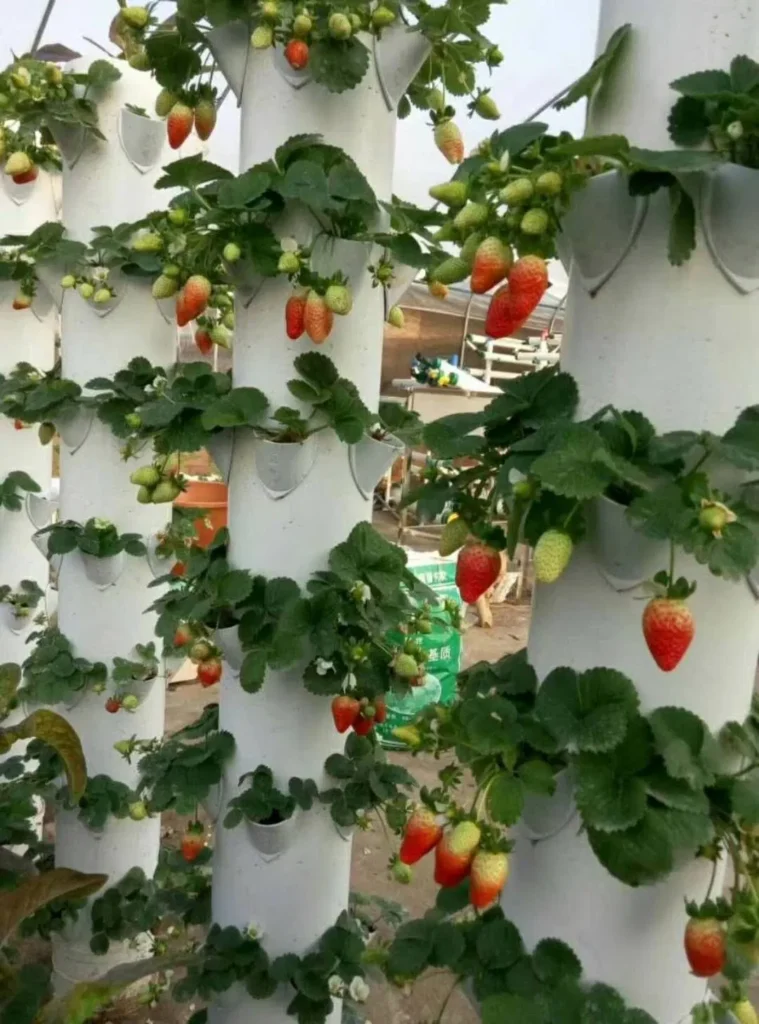
- Choose a suitable location for your tower, with adequate light, temperature, and air circulation.
- Drill holes in your containers, and stack them on top of each other, leaving some space between them.
- Fill the containers with a suitable growing medium, such as coco coir, perlite, or rockwool.
- Insert the plants into the holes, and secure them with clips or ties.
- Connect a water pump and a reservoir to the top container, and run a drip line through the tower, to deliver water and nutrients to the plants.
- Check the pH and EC of the nutrient solution regularly, and adjust as needed.
- Prune and train the plants to prevent overcrowding and improve airflow.
- Maintenance and care for optimal growth
- Water the plants daily, or as needed, depending on the weather and the size of the reservoir.
- Feed the plants with a balanced hydroponic nutrient solution, following the manufacturer’s instructions.
- Monitor the plants for any signs of pests or diseases, and treat them with natural or organic methods, such as neem oil, insecticidal soap, or diatomaceous earth.
- Harvest the fruits when they are ripe, and enjoy your fresh hydroponic strawberries.
Hydroponic Strawberry Plants
Hydroponic strawberry plants are plants that are specially bred or selected for hydroponic cultivation. They are usually propagated from runners, cuttings, or tissue culture, and are sold as bare-root or plug plants. Hydroponic strawberry plants have several advantages over soil-grown plants, such as faster growth, higher productivity, and longer shelf life.
Selection and preparation of plants
- Choose hydroponic strawberry plants that are suitable for your climate and growing system. Some of the most popular varieties are Albion, Seascape, Monterey, and San Andreas.
- Buy healthy and disease-free plants from reputable sources, and inspect them for any signs of damage or infection.
- Soak the plants in water for a few hours, and trim any dead or damaged roots or leaves.
- Transplant the plants into your hydroponic system, and allow them to acclimate for a few days, before applying full-strength nutrient solution.
Table with a list of different varieties of strawberries that can be grown hydroponically.
| Variety | Type | Growth Conditions | Species Specific Requirements |
|---|---|---|---|
| Albion | Day-neutral | Full sun or artificial light, 18 to 22°C (65 to 72°F), 5.5 to 6.5 pH, 1.2 to 1.8 mS/cm EC | High potassium and calcium, moderate nitrogen and phosphorus, low magnesium and sulfur |
| Seascape | Day-neutral | Full sun or artificial light, 18 to 22°C (65 to 72°F), 5.5 to 6.5 pH, 1.2 to 1.8 mS/cm EC | High potassium and calcium, moderate nitrogen and phosphorus, low magnesium and sulfur |
| Quinault | Day-neutral | Full sun or artificial light, 18 to 22°C (65 to 72°F), 5.5 to 6.5 pH, 1.2 to 1.8 mS/cm EC | High potassium and calcium, moderate nitrogen and phosphorus, low magnesium and sulfur |
| Tribute | Day-neutral | Full sun or artificial light, 18 to 22°C (65 to 72°F), 5.5 to 6.5 pH, 1.2 to 1.8 mS/cm EC | High potassium and calcium, moderate nitrogen and phosphorus, low magnesium and sulfur |
| Mara de bois | Day-neutral | Full sun or artificial light, 18 to 22°C (65 to 72°F), 5.5 to 6.5 pH, 1.2 to 1.8 mS/cm EC | High potassium and calcium, moderate nitrogen and phosphorus, low magnesium and sulfur |
| Ozark Beauty | Ever-bearing | Full sun or artificial light, 18 to 22°C (65 to 72°F), 5.5 to 6.5 pH, 1.2 to 1.8 mS/cm EC | High potassium and calcium, moderate nitrogen and phosphorus, low magnesium and sulfur |
| Ft. Laramie | Ever-bearing | Full sun or artificial light, 18 to 22°C (65 to 72°F), 5.5 to 6.5 pH, 1.2 to 1.8 mS/cm EC | High potassium and calcium, moderate nitrogen and phosphorus, low magnesium and sulfur |
| Alpine | June-bearing | Full sun or artificial light, 18 to 22°C (65 to 72°F), 5.5 to 6.5 pH, 1.2 to 1.8 mS/cm EC | High potassium and calcium, moderate nitrogen and phosphorus, low magnesium and sulfur |
| Brigitta | June-bearing | Full sun or artificial light, 18 to 22°C (65 to 72°F), 5.5 to 6.5 pH, 1.2 to 1.8 mS/cm EC | High potassium and calcium, moderate nitrogen and phosphorus, low magnesium and sulfur |
| Chandler | June-bearing | Full sun or artificial light, 18 to 22°C (65 to 72°F), 5.5 to 6.5 pH, 1.2 to 1.8 mS/cm EC | High potassium and calcium, moderate nitrogen and phosphorus, low magnesium and sulfur |
| Earliglow | June-bearing | Full sun or artificial light, 18 to 22°C (65 to 72°F), 5.5 to 6.5 pH, 1.2 to 1.8 mS/cm EC | High potassium and calcium, moderate nitrogen and phosphorus, low magnesium and sulfur |
| Garden Princess | June-bearing | Full sun or artificial light, 18 to 22°C (65 to 72°F), 5.5 to 6.5 pH, 1.2 to 1.8 mS/cm EC | High potassium and calcium, moderate nitrogen and phosphorus, low magnesium and sulfur |
The exact growth conditions and species specific requirements may vary depending on the variety, the system, and the environment of the strawberries. Therefore, it is important to monitor and adjust the variables regularly, to ensure the optimal growth and yield of the strawberries.
What are hydroponically grown strawberries?
Hydroponically grown strawberries are strawberries that are grown in a soilless system, using water and nutrients to produce delicious and nutritious fruits. Hydroponically grown strawberries have better quality, higher yield, lower cost, and lower environmental impact than soil-grown strawberries.

Nutrients and pH Levels
Nutrients and pH levels are crucial factors for the growth and development of hydroponic strawberries. Hydroponic strawberries require a balanced and complete nutrient solution, that provides all the essential macro and micro nutrients, such as nitrogen, phosphorus, potassium, calcium, magnesium, iron, zinc, etc. Hydroponic strawberries also require a stable and optimal pH level, that allows for the proper absorption and utilization of the nutrients.
Essential hydroponic strawberries nutrients
Hydroponic strawberries need a nutrient solution that has an EC (electrical conductivity) of 1.2 to 1.8 mS/cm, and a NPK (nitrogen, phosphorus, potassium) ratio of 1:1:1 or 2:1:2, depending on the stage of growth. The nutrient solution should also contain adequate amounts of calcium, magnesium, sulfur, iron, zinc, manganese, boron, copper, and molybdenum, to prevent any deficiencies or toxicities.
Hydroponic strawberries can be fed with either a single-part or a two-part nutrient solution, that is specially formulated for strawberries, or a general-purpose hydroponic nutrient solution, that is suitable for fruiting crops. The nutrient solution should be mixed with water, following the manufacturer’s instructions, and should be changed every two weeks, or as needed.
The table below provides information about nutrients required for growing strawberries hydroponically at different stages of life cycle. Here is a possible table:
| Stage of Life Cycle | Macro Nutrients (ppm) | Micro Nutrients (ppm) | EC (mS/cm) | pH |
|---|---|---|---|---|
| Seed Germination | N: 50-100, P: 50-100, K: 50-100 | Ca: 100-200, Mg: 50-100, S: 50-100, Fe: 1-2, Zn: 0.1-0.5, Mn: 0.5-1, B: 0.5-1, Cu: 0.05-0.1, Mo: 0.01-0.05 | 0.8 to 1.2 | 5.5 to 6.0 |
| Vegetative Growth | N: 100-200, P: 50-100, K: 100-200 | Ca: 200-300, Mg: 50-100, S: 50-100, Fe: 2-3, Zn: 0.5-1, Mn: 1-2, B: 1-2, Cu: 0.1-0.2, Mo: 0.05-0.1 | 1.2 to 1.8 | 5.5 to 6.5 |
| Flowering and Fruiting | N: 50-100, P: 100-200, K: 200-300 | Ca: 300-400, Mg: 50-100, S: 50-100, Fe: 3-4, Zn: 1-2, Mn: 2-3, B: 2-3, Cu: 0.2-0.3, Mo: 0.1-0.2 | 1.2 to 1.8 | 5.5 to 6.5 |
The exact nutrient requirements may vary depending on the variety, the system, and the environment of the strawberries. Therefore, it is important to monitor and adjust the nutrient solution regularly, to ensure the optimal growth and yield of the strawberries.
Maintaining strawberry pH level in hydroponics
Hydroponic strawberries need a pH level of 5.5 to 6.5, to ensure the optimal availability and uptake of the nutrients. The pH level should be checked daily, using a pH meter, test strips, or indicator solution, and should be adjusted as needed, using pH up or pH down products, such as phosphoric acid, citric acid, potassium hydroxide, or sodium bicarbonate.
The pH level may fluctuate due to various factors, such as the quality of water, the type of growing medium, the concentration of nutrients, the temperature, and the plant metabolism. Therefore, it is important to monitor and maintain the pH level regularly, to avoid any problems or imbalances.
Seeds Selection
Seeds selection is another important aspect of growing hydroponic strawberries. Hydroponic strawberries can be grown from seeds, as well as from runners, cuttings, or tissue culture. However, growing hydroponic strawberries from seeds has some advantages, such as lower cost, higher genetic diversity, and longer shelf life.
Where to buy strawberry seeds for hydroponics
Strawberry seeds for hydroponics can be bought from online retailers, seed catalogs, or local nurseries, that offer a wide range of varieties, such as Alpine, Alexandria, Temptation, or Fragaria vesca. Strawberry seeds for hydroponics should be fresh, viable, and certified, to ensure the best germination and quality.
Germinating hydroponic strawberry seeds
- Hydroponic strawberry seeds can be germinated in a moist and sterile growing medium, such as rockwool, peat pellets, or vermiculite, or in a wet paper towel, placed in a ziplock bag. Hydroponic strawberry seeds need light, warmth, and humidity, to germinate, and may take two to four weeks, to sprout.
- Hydroponic strawberry seeds should be sown thinly, and lightly covered with the growing medium, or pressed gently into the paper towel. The seeds should be kept moist, but not soggy, and should be exposed to 12 to 14 hours of light, and a temperature of 18 to 22°C, or 65 to 72°F. The seeds should be misted daily, and ventilated occasionally, to prevent mold or damping off.
- Hydroponic strawberry seeds should be transplanted into the hydroponic system, when they have two to four true leaves, and a healthy root system. The seedlings should be handled carefully, and should be acclimated gradually, to the new environment.
Growing Hydroponically
Growing hydroponically is a method of growing plants without soil, using water and nutrients to provide the optimal conditions for growth, development, and yield. Growing hydroponically has many benefits, such as saving water, space, and time, increasing productivity and quality, and reducing pests and diseases. Growing hydroponically also allows for more control and flexibility, as the growers can adjust the variables, such as light, temperature, humidity, and pH, to suit the needs of the plants.
How to grow hydroponic strawberries
Hydroponic strawberries can be grown in various hydroponic systems, such as ebb and flow, drip, NFT, or aeroponics, depending on the preference and budget of the growers. Hydroponic strawberries can also be grown in different types of growing media, such as coco coir, perlite, rockwool, or clay pebbles, depending on the availability and suitability of the media. Hydroponic strawberries can be grown in any location, such as indoors, outdoors, or in a greenhouse, depending on the climate and space available.
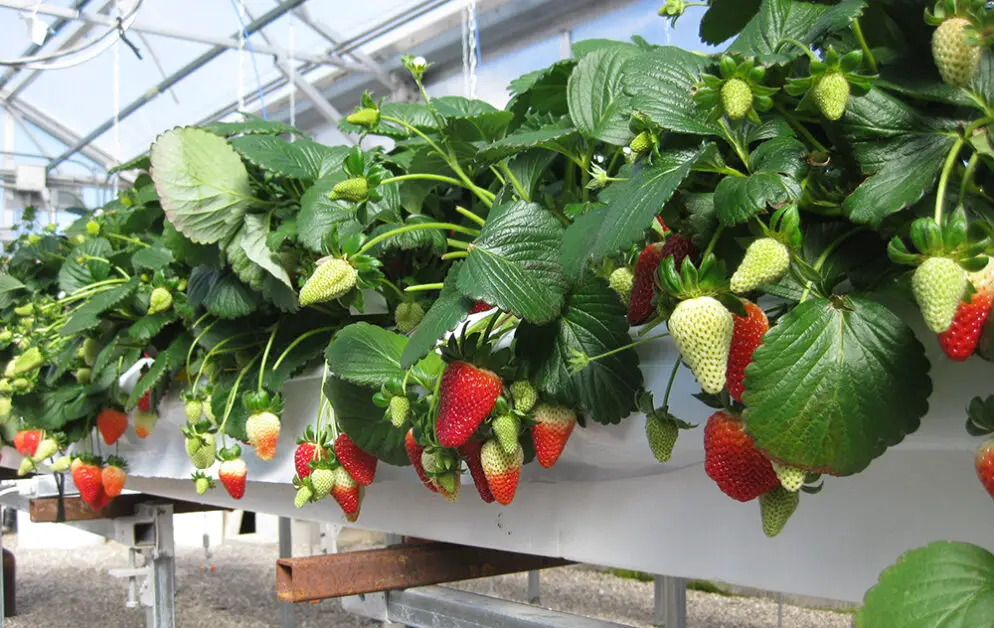
The basic steps for growing hydroponic strawberries are:
- Choose a suitable hydroponic system, growing medium, and location for your strawberries, and set up the system according to the instructions.
- Select healthy and disease-free strawberry plants or seeds, and prepare them for transplanting or germinating.
- Transplant the plants or sow the seeds into the hydroponic system, and allow them to acclimate for a few days, before applying full-strength nutrient solution.
- Water and feed the plants with a balanced and complete hydroponic nutrient solution, following the manufacturer’s instructions, and check the pH and EC of the solution regularly, and adjust as needed.
- Provide adequate light, temperature, humidity, and air circulation, to the plants, using artificial lights, fans, heaters, or humidifiers, as needed.
- Monitor the plants for any signs of pests or diseases, and treat them with natural or organic methods, such as neem oil, insecticidal soap, or diatomaceous earth.
- Prune and train the plants to prevent overcrowding and improve airflow, and remove any runners or flowers, to encourage fruiting.
- Harvest the fruits when they are ripe, and enjoy your fresh hydroponic strawberries.
DIY Hydroponics
DIY hydroponics is a method of growing plants without soil, using homemade or recycled materials, such as bottles, jars, buckets, or pipes, to create a simple and affordable hydroponic system. DIY hydroponics has many benefits, such as saving money, reducing waste, and having fun. DIY hydroponics also allows for more creativity and customization, as the growers can design and build their own hydroponic system, according to their needs and preferences.
DIY hydroponic strawberries
DIY hydroponic strawberries are strawberries that are grown in a homemade or recycled hydroponic system, using water and nutrients to produce delicious and nutritious fruits. DIY hydroponic strawberries are easy and cheap to grow, and can be a great project for beginners, hobbyists, or kids.
Step-by-step guide on DIY hydroponic strawberries
- Choose a suitable container for your hydroponic system, such as a bottle, a jar, a bucket, or a pipe, and clean it thoroughly.
- Cut or drill holes in your container, and insert a net pot, a wick, or a sponge, to hold the plant and the growing medium.
- Fill the net pot, the wick, or the sponge, with a suitable growing medium, such as coco coir, perlite, or rockwool.
- Insert the plant or the seed into the growing medium, and secure it with clips or ties.
- Fill the container with water, and add a hydroponic nutrient solution, following the manufacturer’s instructions, or make your own nutrient solution, using household items, such as Epsom salt, baking soda, or vinegar.
- Place the container in a sunny spot, or under artificial lights, and check the water level and the nutrient concentration regularly, and refill or change as needed.
- Monitor the plant for any signs of pests or diseases, and treat them with natural or organic methods, such as neem oil, insecticidal soap, or diatomaceous earth.
- Harvest the fruits when they are ripe, and enjoy your DIY hydroponic strawberries.
Cost-effective ways to grow your own berries
- DIY hydroponic strawberries are cost-effective, as they use minimal and inexpensive materials, and require little maintenance and care. Some of the ways to grow your own berries in a cost-effective way are:
- Use recycled or repurposed materials, such as bottles, jars, buckets, or pipes, to create your hydroponic system, and avoid buying new or expensive equipment.
- Use organic or natural growing media, such as coco coir, peat moss, or vermiculite, which are cheaper and more sustainable than synthetic media, such as rockwool, or clay pebbles.
- Use organic or natural nutrients, such as fish emulsion, seaweed extract, or worm castings, which are cheaper and more eco-friendly than synthetic nutrients, such as mineral salts, or chemical fertilizers.
- Use rainwater, tap water, or filtered water, to fill your hydroponic system, and avoid using distilled water, or bottled water, which are more expensive and wasteful.
- Use natural or organic methods, such as biological control, physical control, or botanical control, to prevent and treat pests and diseases, and avoid using chemical pesticides, or herbicides, which are more expensive and harmful.
Growing Hydroponic Strawberries Indoors
Growing hydroponic strawberries indoors is a method of growing plants without soil, using water and nutrients, in an indoor environment, such as a room, a closet, or a tent. Growing hydroponic strawberries indoors has many benefits, such as extending the growing season, avoiding weather fluctuations, and increasing security and privacy. Growing hydroponic strawberries indoors also allows for more control and precision, as the growers can manipulate the variables, such as light, temperature, humidity, and CO2, to optimize the growth, development, and yield of the plants.
Setting up your indoor garden
- Setting up your indoor garden is the first step for growing hydroponic strawberries indoors. You need to choose a suitable location, system, and equipment, for your indoor garden, and set them up according to the instructions.
- Choose a suitable location for your indoor garden, such as a room, a closet, or a tent, that has enough space, power outlets, ventilation, and access. The location should be clean, dry, dark, and secure, to prevent any contamination, mold, light leaks, or theft.
- Choose a suitable system for your indoor garden, such as ebb and flow, drip, NFT, or aeroponics, depending on the preference and budget of the growers. The system should be easy to use, maintain, and clean, and should fit the space and the plants.
- Choose suitable equipment for your indoor garden, such as lights, fans, heaters, humidifiers, timers, thermometers, hygrometers, pH meters, EC meters, and CO2 generators, depending on the needs and goals of the growers. The equipment should be reliable, efficient, and safe, and should provide the optimal conditions for the plants.
Care tips for indoor hydroponic strawberries
Care tips for indoor hydroponic strawberries are the best practices for growing hydroponic strawberries indoors. You need to provide adequate light, temperature, humidity, and CO2, to the plants, and monitor and adjust them as needed. You also need to water and feed the plants with a balanced and complete hydroponic nutrient solution, and check the pH and EC of the solution regularly, and adjust as needed. You also need to monitor the plants for any signs of pests or diseases, and treat them with natural or organic methods. You also need to prune and train the plants to prevent overcrowding and improve airflow, and remove any runners or flowers, to encourage fruiting. You also need to harvest the fruits when they are ripe, and enjoy your indoor hydroponic strawberries.
Table of requirements for growing strawberries indoor with the parameters for optimal growth.
| Parameter | Optimal Value |
|---|---|
| Light | 12 to 14 hours per day, full spectrum, 400 to 600 µmol/m2/s |
| Temperature | 18 to 22°C (65 to 72°F) |
| Humidity | 50 to 70% |
| Air circulation | Moderate to high |
| pH | 5.5 to 6.5 |
| EC | 1.2 to 1.8 mS/cm |
| NPK ratio | 1:1:1 or 2:1:2 for vegetative growth, 1:2:3 or 2:3:4 for flowering and fruiting |
| Calcium | 200 to 400 ppm |
| Magnesium | 50 to 100 ppm |
| Sulfur | 50 to 100 ppm |
| Iron | 2 to 4 ppm |
| Zinc | 0.5 to 2 ppm |
| Manganese | 0.5 to 3 ppm |
| Boron | 0.5 to 3 ppm |
| Copper | 0.05 to 0.3 ppm |
| Molybdenum | 0.01 to 0.2 ppm |
The exact requirements may vary depending on the variety, the system, and the environment of the strawberries. Therefore, it is important to monitor and adjust the parameters regularly, to ensure the optimal growth and yield of the strawberries.
Conclusion
Hydroponic strawberries are strawberries that are grown in a soil less system, using water and nutrients to produce delicious and nutritious fruits. Hydroponic strawberries have many advantages over soil-grown strawberries, such as better quality, higher yield, lower cost, and lower environmental impact. Hydroponic strawberries can be grown using different techniques and equipment, such as hydroponic strawberry tower, hydroponic strawberry plants, nutrients and pH levels, and seeds selection. Hydroponic strawberries
FAQs: Growing Hydroponic Strawberries Indoors
Q: How much light do my indoor hydroponic strawberries need?
A: Indoor hydroponic strawberries need 12 to 14 hours of light per day, to grow and fruit well. The light should have a spectrum that is suitable for fruiting crops, such as red and blue, and should have an intensity that is sufficient for photosynthesis, such as 400 to 600 µmol/m2/s. The light can be provided by artificial lights, such as LED, HID, or CFL, or by natural light, such as windows, skylights, or sunrooms. The light should be placed close to the plants, but not too close, to avoid burning or shading them.
Q: Can I control the flavor profile by adjusting the nutrients?
A: Yes, you can control the flavor profile by adjusting the nutrients, as the nutrients affect the sugar, acid, and aroma content of the fruits. For example, you can increase the sweetness by increasing the potassium, decrease the acidity by increasing the calcium, and enhance the aroma by increasing the magnesium. However, you should not overdo it, as too much or too little of any nutrient can cause problems or imbalances. You should follow the manufacturer’s instructions, and use a balanced and complete hydroponic nutrient solution, that is specially formulated for strawberries, or a general-purpose hydroponic nutrient solution, that is suitable for fruiting crops.
Q: What equipment do I need for my own DIY hydroponic strawberries setup?
- A: The basic equipment that you need for your own DIY hydroponic strawberries setup are:
- A container, such as a bottle, a jar, a bucket, or a pipe, to hold the water and the nutrients.
- A net pot, a wick, or a sponge, to hold the plant and the growing medium.
- A growing medium, such as coco coir, perlite, or rockwool, to support the plant and the root system.
- A plant or a seed, to grow the strawberries.
- A hydroponic nutrient solution, to feed the plant and the fruits.
- A light source, such as the sun, or artificial lights, to provide the energy for photosynthesis.
Q: How long does it take to grow strawberries using the DIY method?
A: The time that it takes to grow strawberries using the DIY method depends on several factors, such as the variety, the growing conditions, and the care. In general, it may take two to four weeks, to germinate the seeds, four to six weeks, to grow the plants, and eight to twelve weeks, to produce the fruits. Therefore, it may take three to six months, to grow strawberries from seeds, using the DIY method.

Suyash Dhoot, editor at SouthElMonteHydroponics.com, is a pioneering force in hydroponics. His expertise spans nutrient solutions and cutting-edge technology. Through meticulous editing, he elevates the site to a beacon of knowledge, offering invaluable insights. Dhoot’s dedication shapes a greener, more efficient future for agriculture.


